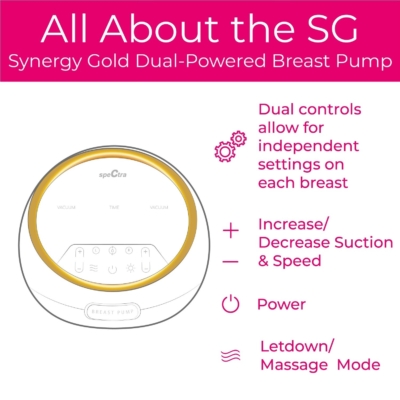Breastfeeding Tips for Success
By: Rue Khosa, MSN, FNP-BC, IBCLC
We recently had a chance to chat with Rue Khosa, a Board-Certified Family Nurse Practitioner, Lactation Consultant, and new momma of baby #3. She shares her expert advice on preparing for your delivery, planning for the return to work, and why Spectra Baby USA breast pumps are her top pick.
Before Delivery
✔ Book a Prenatal Lactation Consult
I firmly believe every expectant couple should book a prenatal lactation consult. Getting a review of your medical history, a breast assessment, and help to select the right pump for you is vital. Knowing I was going back to work at just 6-weeks postpartum, I knew getting the perfect pump to establish my supply and build a frozen stash was critical to my successfully maintaining supply.
Find and book your prenatal consult with an IBCLC around 28-34 weeks.
✔ Order your Breast Pump
I was fortunate enough to receive the Spectra Synergy Gold pump to review! The Spectra Synergy Gold electric breast pump uses advanced technology with dual motors allowing you to adjust each side independently. Furthermore, it’s a hospital strength closed system making it effective and efficient to establish and maintain my supply despite my hectic schedule.
Before you deliver, you will want to order your pump, wash the pump parts, and get familiar with using it. There is nothing more stressful than trying to read a pump manual with a hangry newborn wailing next to you. Find out if your insurance covers a Spectra baby USA here.
After Delivery
✔ Establish your Supply
When it comes to breastfeeding, demand equals supply. The more you demand of your breasts by stimulating and emptying them frequently, the more milk you will make. Therefore, breastfeeding your newborn a minimum of 10-12 times a day or every 2hrs during the first couple of weeks is crucial. Equally important is making sure you are breastfeeding effectively. If your newborn is unable to latch and nurse effectively or at all, then you will need your breast pump to pick up the slack while you work with your IBCLC to assess and establish breastfeeding.
Prolactin, the hormone responsible for milk production, returns to pre-pregnancy levels in the first two weeks postpartum if there is inadequate breast stimulation. This makes it increasingly more challenging to restore and recover your milk supply the further postpartum you are.
✔ Build a Stash
The word stash can often sound intimidating, but it is essential to remember that the goal is to feed your baby, not the freezer. You want to store 2-4oz a day, helping build a 4-7 day reserve by the time you return to work at 12 weeks.
If you are not already pumping, you will want to start pumping around four weeks postpartum. This will allow you to take advantage of higher prolactin levels and corresponding higher milk supply in the immediate postpartum period. Pumping after the first and last feed of the day for 10-15mins is more than sufficient.
✔ Contact HR
Thanks to the Obama administration, not only do we have better lactation services insurance coverage, but employers have to provide pumping breaks and designated pumping rooms for new mothers. Contact your HR department 2-4 weeks before your expected return to make sure that they make appropriate accommodations for you.
On the Job
Now you are ready to go back to work. Know that most women are bound to experience a decrease in their supply as they return to the workforce. Many factors, including work stress, decreased hydration, decreased breast stimulation, as well as the natural regulation of your milk supply around the 12-week time frame, contribute to this decrease. If you have followed all of the above steps, you are less likely to experience a dramatic drop. Additionally, to maintain your supply, you will want to pump at least every 3hrs while at work. I recommend pumping right before you leave for work to give you time to settle in before you have to pump again. You also want to coordinate the last pump of the day and the baby’s first breastfeed when you get home. Ask whoever is caring for your little one to avoid bottle feeding 2hrs before you are due to return home and likewise avoid pumping during that same time frame. If schedules allow, this will save you a pump session and give you both a much-needed bonding experience after a long day apart.
To save time, Spectra has created the Simple Store Solution Kit, which allows you to pump, store and feed your baby all from the same bag.
Take Away
Only 12% of women have access to paid maternity leave, and up to 25% of women have to return to work just two weeks after giving birth. Whether you are returning to work at two weeks or 12 weeks, the stress and anxiety around the transition can have devastating effects on your breastmilk supply. In a perfect world, we would all have the option of staying home with our little ones for as long as we desire. However, by following the above steps, you will have the next best thing, the best shot at being able to exclusively feed your baby breastmilk through the first year and beyond.
Good luck, mama, you got this!
Rue Khosa is a Board-Certified Family Nurse Practitioner and Lactation Consultant. She has dedicated her career to being a women’s health advocate supporting new and expectant parents to thrive through the parenting journey. Believing it takes a village to raise a child, she has created a global village of women centered around mutual respect, trust, and unconditional support. Follow her on Instagram @rue_theboobboss for all things Bumps, Babies, and Boobs.



